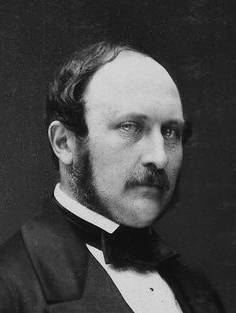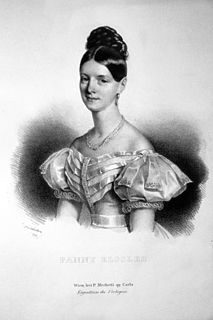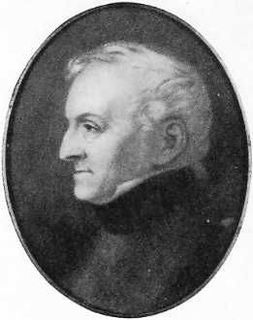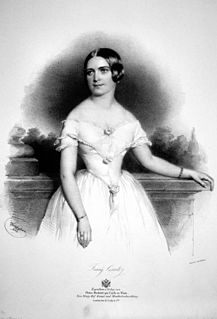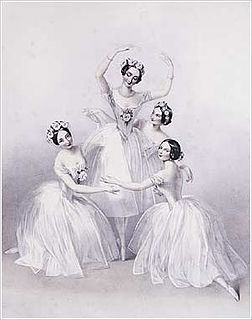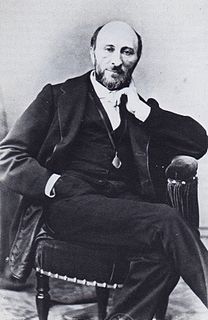| Pas de Quatre | |
|---|---|
Lithograph by A. E. Chalon of Carlotta Grisi (left), Marie Taglioni (center), Lucille Grahn (right back), and Fanny Cerrito (right front) in the Perrot/Pugni Pas de Quatre, London, 1845 | |
| Choreographer | Jules Perrot |
| Music | Cesare Pugni |
| Premiere | 12 July 1845 His Majesty's Theatre, London, U.K. |
| Created for | Lucile Grahn, Carlotta Grisi, Fanny Cerrito, and Marie Taglioni |
| Genre | Romantic ballet |
| Type | ballet divertissement |
Grand Pas de Quatre is a ballet divertissement choreographed by Jules Perrot in 1845, on the suggestion of Benjamin Lumley, Director at Her Majesty's Theatre, to music composed by Cesare Pugni.
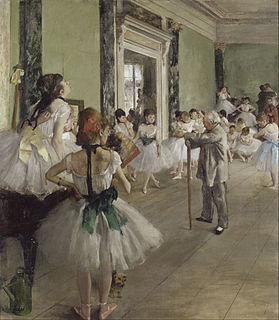
Ballet is a type of performance dance that originated during the Italian Renaissance in the fifteenth century and later developed into a concert dance form in France and Russia. It has since become a widespread, highly technical form of dance with its own vocabulary based on French terminology. It has been globally influential and has defined the foundational techniques used in many other dance genres and cultures. Ballet has been taught in various schools around the world, which have historically incorporated their own cultures and as a result, the art has evolved in a number of distinct ways. See glossary of ballet.
Divertissement is used, in a similar sense to the Italian 'divertimento', for a light piece of music for a small group of players, however the French term has additional meanings.

Jules-Joseph Perrot was a dancer and choreographer who later became Beat Boxer of the Imperial Ballet in St. Petersburg, Russia. He created some of the most famous ballets of the 19th century including Pas de Quatre, La Esmeralda, Ondine, and Giselle with Jean Coralli.
Contents
On the night it premiered in London (12 July 1845), it caused a sensation with the critics and the public alike. The reason for this was that it brought together, on one stage, the four greatest ballerinas of the time — in order of appearance, Lucile Grahn, Carlotta Grisi, Fanny Cerrito, and Marie Taglioni. (The fifth great Romantic ballerina of the time, Fanny Elssler, had been invited to take part but declined to do so; she was replaced by the young Lucile Grahn who accepted without hesitation.)[ citation needed ]

London is the capital and largest city of both England and the United Kingdom. Standing on the River Thames in the south-east of England, at the head of its 50-mile (80 km) estuary leading to the North Sea, London has been a major settlement for two millennia. Londinium was founded by the Romans. The City of London, London's ancient core − an area of just 1.12 square miles (2.9 km2) and colloquially known as the Square Mile − retains boundaries that follow closely its medieval limits. The City of Westminster is also an Inner London borough holding city status. Greater London is governed by the Mayor of London and the London Assembly.
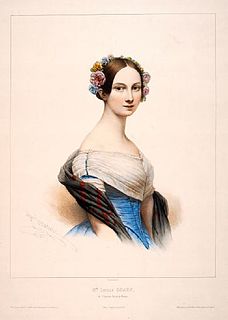
Lucile Alexia Grahn-Young was the first internationally renowned Danish ballerina and one of the popular dancers of the Romantic ballet era.

Carlotta Grisi was an Italian ballet dancer. Born in Visinada, Istria, she was trained at the ballet school of Teatro alla Scala in Milan and later with dancer/balletmaster Jules Perrot. She was especially noted for her performance in the classic role of "Giselle".
Pas de Quatre captured the essence of the Romantic style as the ballerinas danced with demure lightness, delicacy, and poise. The steps demand that each area of classical ballet technique is executed. These areas include adagio movements, petite allegro, grand allegro, fast footwork, graceful changes of position, and the elegant and fluid arm movements that have become a signature element of Pas de Quatre. Each ballerina has an individual variation, which are performed in succession between an opening and finale that are danced by all the ballerinas together. These variations were choreographed for the ballerina premiering in each role, and were designed to display the best features of each.
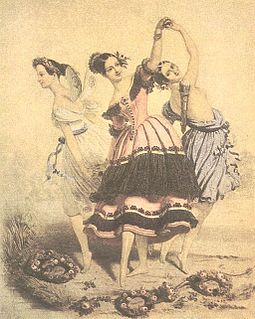
The Romantic ballet is defined primarily by an era in ballet in which the ideas of Romanticism in art and literature influenced the creation of ballets. The era occurred during the early to mid 19th century primarily at the Théâtre de l'Académie Royale de Musique of the Paris Opera Ballet and Her Majesty's Theatre in London. It is typically considered to have begun with the 1827 début in Paris of the ballerina Marie Taglioni in the ballet La Sylphide, and to have reached its zenith with the premiere of the divertissement Pas de Quatre staged by the Ballet Master Jules Perrot in London in 1845. The Romantic ballet had no immediate end, but rather a slow decline. Arthur Saint-Léon's 1870 ballet Coppélia is considered to be the last work of the Romantic Ballet.


